All you need to know about your products!

| 3DNews Vendor Reference English Resource - All you need to know about your products! |
||||||
 |
||||||
|
|
||||||
ASUS EAX1600XT SILENTAuthor:Date: 19/04/2006 Aspiration for comfortable work at the computer is one of the most natural desires. And one of the most important components of this comfort is quietness. While in the past we had to sacrifice the performance to attain a comfortable acoustic environment, today the modern mass computer is able providing sufficient power for running any task with comfort. What is left now is to make it work noiselessly. That is why most manufacturers of computer components are offering more and more of such solutions, whereas quiet solutions are getting more powerful. In our test lab today we've got one of such special solutions - the video card ASUS EAX1600XT SILENT. ASUSTeK Computer Inc. has long been gladdening its worshippers with powerful, reliable and in many ways innovative products. The secret of most successful products is just in the development of own printed circuit boards (PCB), or cooling systems, or unique technologies, and sometimes all these taken together. This video card is equipped with a unique noiseless cooling system. But that seems only at first glance. Let's try to estimate the card's features and look for some differences, and as usual we start with the packaging.  The stylish box, following the long-standing tradition of ASUS, is of rather large size, which is not always convenient for transportation but is a good protection against possible damages and pleases the eye of the lucky owner.  Apart form the user's guide, the bundle includes a lot of CDs with electronic manuals, drivers and proprietary utilities, as well as games put into the box as bonus items (Xpand Rally, Savage, BillyBlade, Mashed). 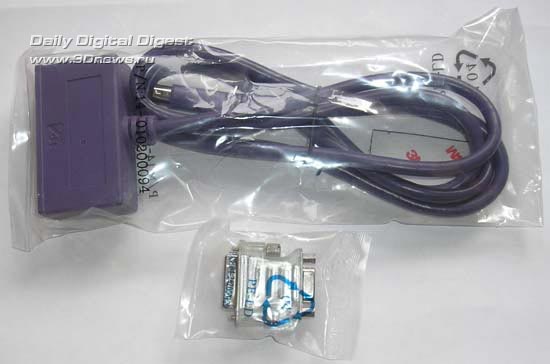 The bundle also contains more useful items like a 15-pin D-Sub/DVI adapter, and a VIVO (9-pin S-Video In/Out, Composite In/Out) cable. 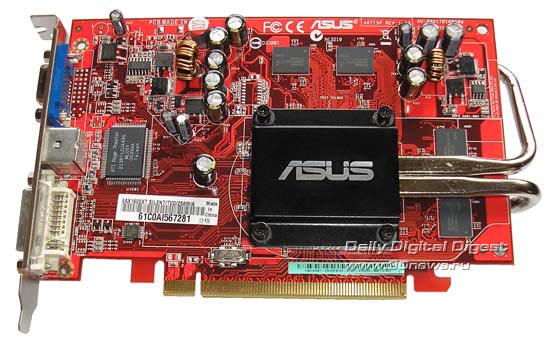 The board is made of scarlet textolyte and is of standard length (to please the owners of compact and cramped housings). The PCB does not provide additional power supply - that means the power consumption does not exceed 75 W. The front side of this video card looks very unusual. Where is the customary cooling system that takes too much space and buzzes annoyingly? Instead of that, there is only a cooler with two heat pipes running onto the board's reverse side. 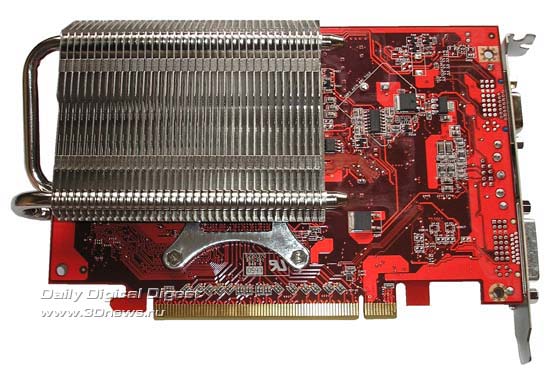 The reverse side of the board by more than half is closed by the cooling system which is positioned closer to the processor cooler, which should definitely improve heat diffusion. The shortcoming of this interesting solution may be only the probable incompatibility of some compact motherboards to large CPU cooling systems, which is not incredible when assembling a quiet CPU unit. 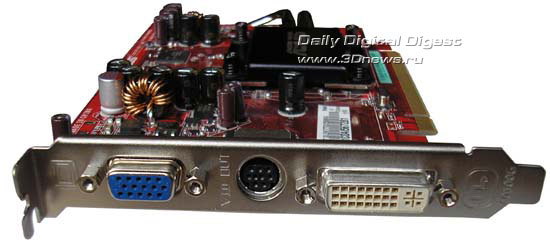 To plug in a monitors and other devices, the video card is equipped with the following interfaces: 15-pin D-Sub, VIVO (through a bundled cable), and DVI. 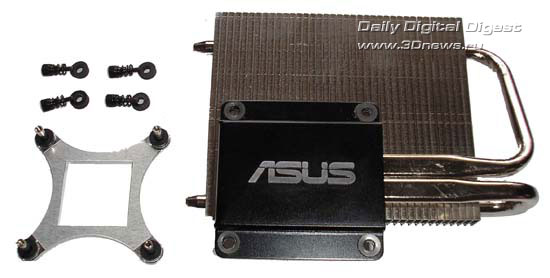 The noiseless cooling system is fastened rather reliable and neatly - the cooler is fastened with four spring-loaded screws to a special frame installed on the reverse side of the board. At the same time, all the fastening components have rubber washers. 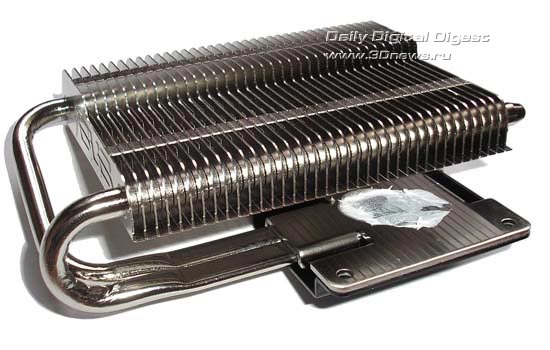 The cooling system itself is made up of a copper cooler and two copper heat pipes, on which 37 thin aluminum plates are forced (without soldering, unfortunately). As the thermal interface between the cooling system and the GPU, white paste (similar to KPT-8) is used in abundance. Unfortunately, the memory chips have no cooling at all. As regards the efficiency of cooler-free cooling of the ATi Radeon X1600XT chip, we couldn't quantify that. Engineers at ASUSTeK have hidden the information of interest away from the users' eyes as further as possible. Neither proprietary (ASUS SmartDoctor) nor third-party (ATITool, RivaTuner, etc.) utilities helped extract the GPU temperatures. But even without precise values the efficiency of the cooling system can be regarded as sufficient (even without additional ventilation), at least due to the possibility to overclock the video card without detriment to the operating stability and image quality. But we'll talk about overclocking a bit later. 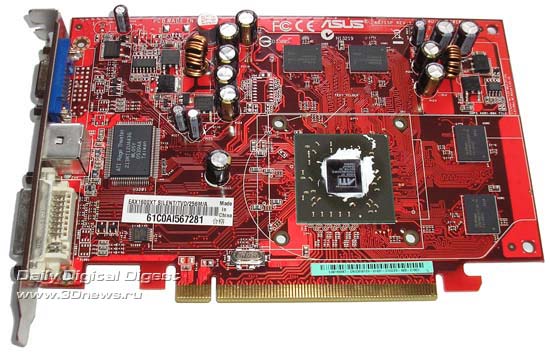 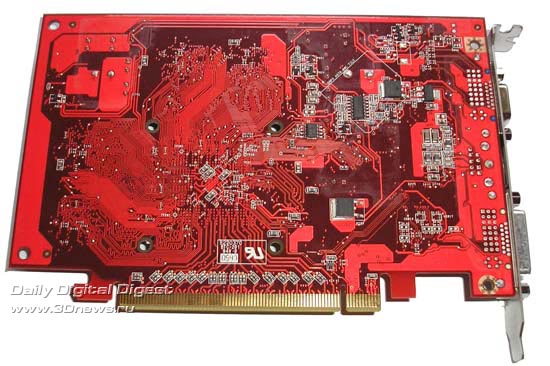 Without the cooling system the video card looks more familiar. 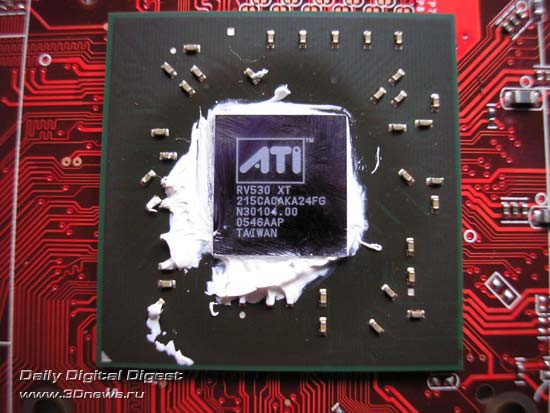 The card uses the GPU RV530 XT which has 12 pixel processors for which there are 4 texture units as well as 6 vertex processors. The GPU was made on the 46th week of year 2005. Its nominal operating clock speed is 590 MHz. In such conditions, the cooling system easily coped with its job. Despite the special purpose of the video card, we tried overclocking the GPU, but we were not pleased by the result - 652 MHz, and saw artifacts at frequencies higher than that. At that, we didn't finish our experiments - on top of the radiator, we fastened a 90-mm Maxtron CF-12925MB fan which runs almost noiselessly (it is absolutely quiet against the noise coming from the PSU fan). After enhancing the cooling system we were able to raise the overclocking capability to 729 MHz, although the chip was able running at greater frequencies, albeit with artifacts and freezes, and at 739 MHz the demanding graphics resulted in hangs. The result is quite decent - without substantial rise in noise we got a 140 MHz frequency boost.  The video card that offers a 128-bit wide memory bus is equipped with four GDDR3 chips installed on the front side, of 256 MB total capacity. The memory chips are made by Infineon Technologies, offer 1.4 ns access time (which is equivalent to the nominal 715 MHz and resultant 1430 MHz). But the memory runs at 693 MHz (1386 MHz DDR). It seems the memory could be overclocked a bit, but raising the frequency by over 2 MHz resulted in a hang. The lack of cooling makes itself felt. The almost zero memory overclocking perhaps won't let feel the fascination of raising the GPU operating frequency. 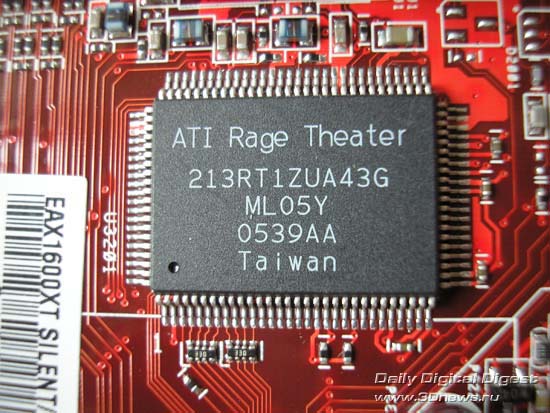 To support the VIVO feature, there is an ATI Rage Theater chip onboard. We ran the tests on the following test bench:
Benchmarking results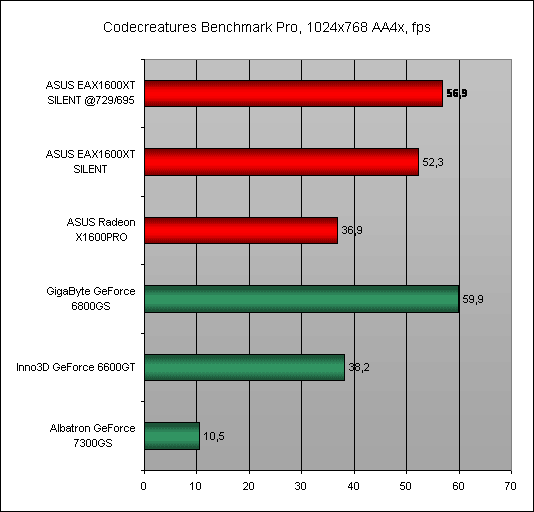 The first OpenGL test shows a substantial superiority over the GeForce 6600GT and some lag from GeForce 6800GS which is of approximately the same price but differs in greater power consumption and noisier cooling system. 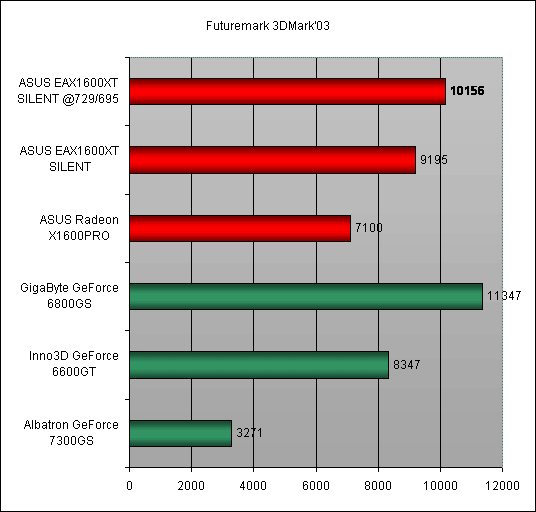 Futuremark 3DMark'03 leaves all on their places although with some results. The overclocking of GPU by 23% improves the performance of ASUS EAX1600XT by merely 10%. 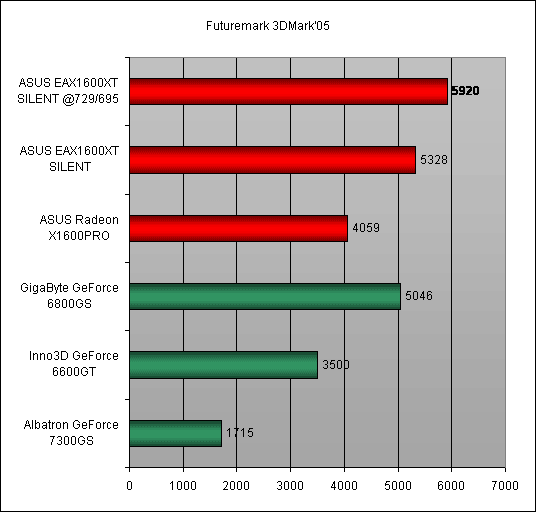 The more shader instructions processed, the better the x1600 series GPUs perform. And at Futuremark 3DMark'05, Radeon X1600XT takes a lead over GeForce 6800GS, which is caused by not the architectural features but the clock speeds. 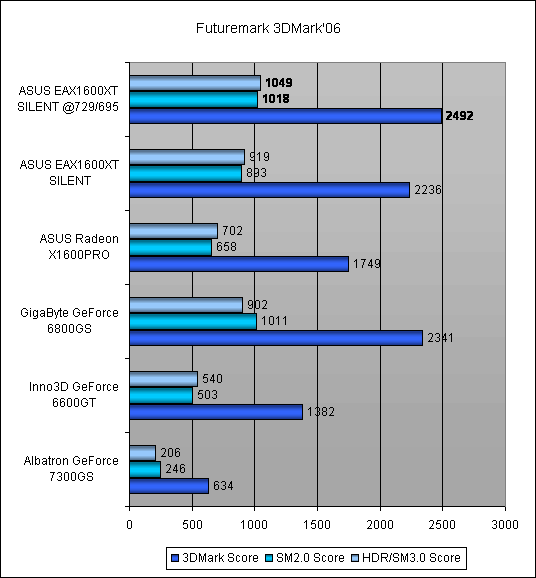 The latest 3DMark shows demonstrates a change of leadership. Interestingly, in the SM2.0 tests the results for Radeon X1600XT and GeForce 6800GS are about the same, and at the advanced technologies SM3.0 and HDR the leadership crown goes to GeForce 6800GS maybe due the high-end origin of the architecture or due to the 256 bit wide memory bus. 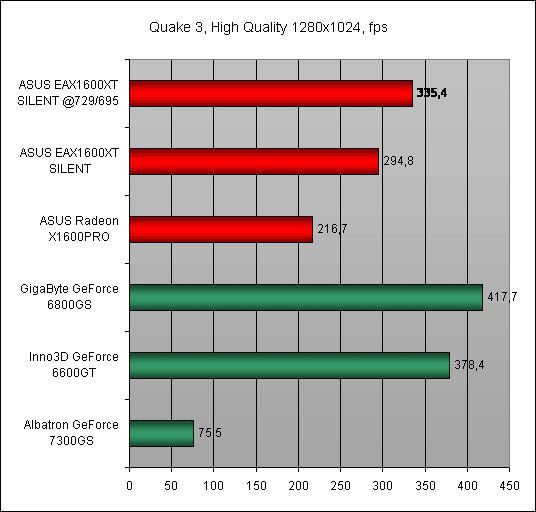 At this "brute-force" test, because Quake 3 has no shader operations, Radeon X1600XT loses to even GeForce 6600GT. 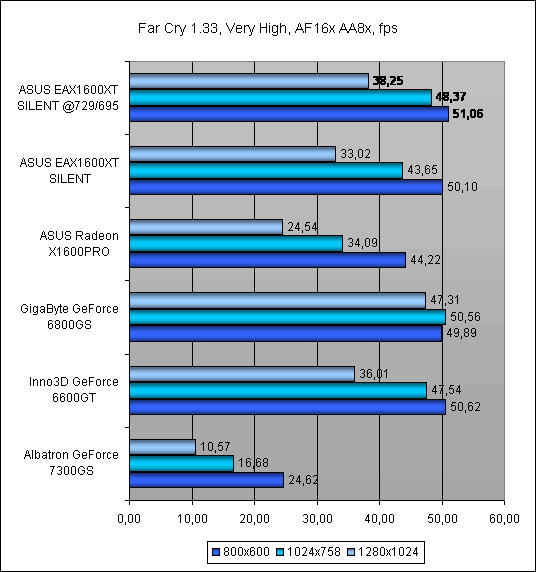 Far Cry updated to the latest version is so demanding that the CPU resources are insufficient to handle 50 FPS. So the major differences should be seen in only high resolutions where X1600XT shows not the best results. 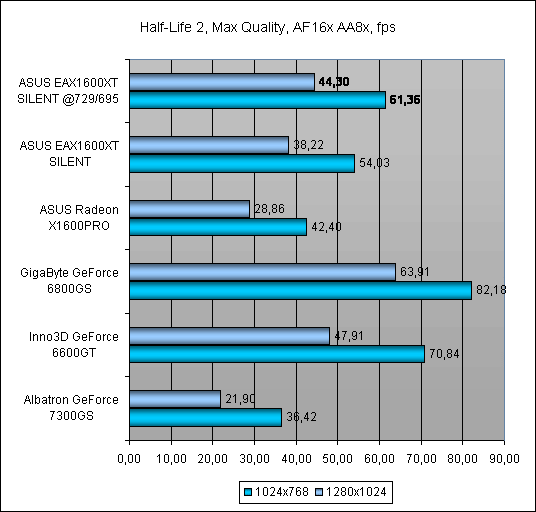 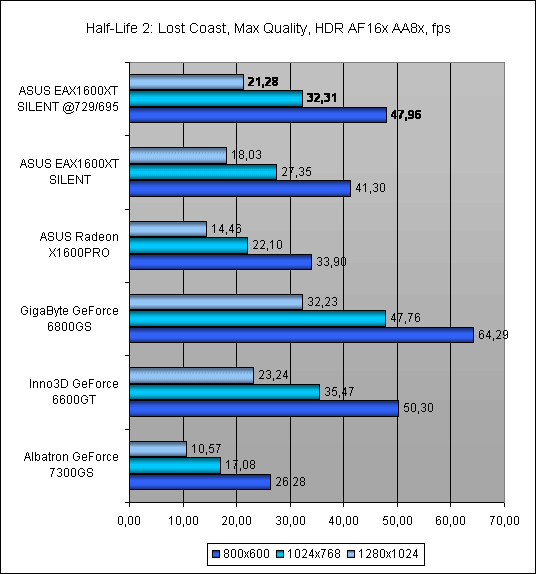 Half-Life 2 offers a more up-to-date graphics engine, but the result does not change - X1600XT shows merely the third result. Transition to the more promising HDR mode in Lost Coast does not change the situation either. 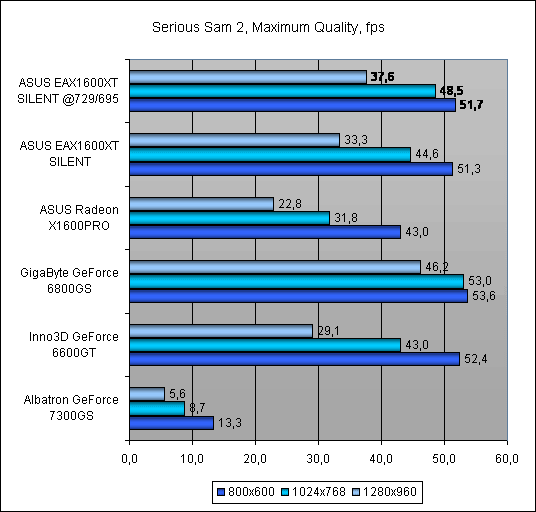 Serious Sam 2 fixes the situation a bit, especially after overclocking but we expected more. 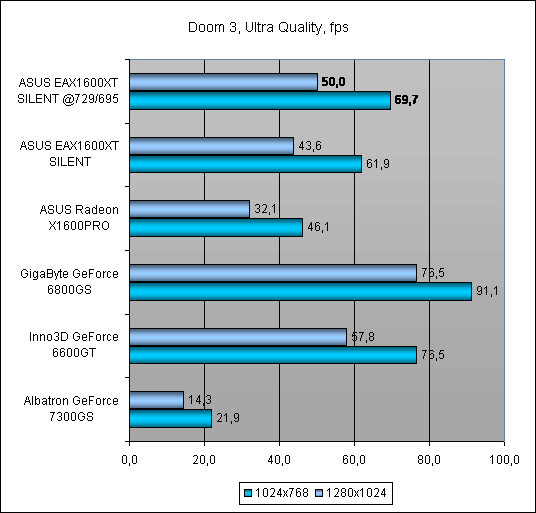 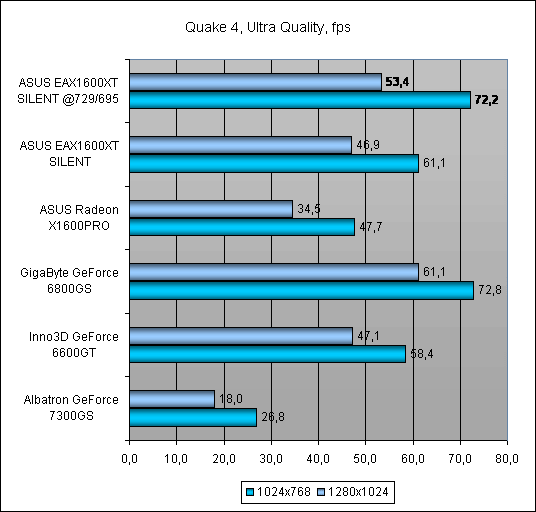 Doom 3 and Quake 4 have long been regarded as a patrimony of NVIDIA graphic processors, so there is no wonder about the results. 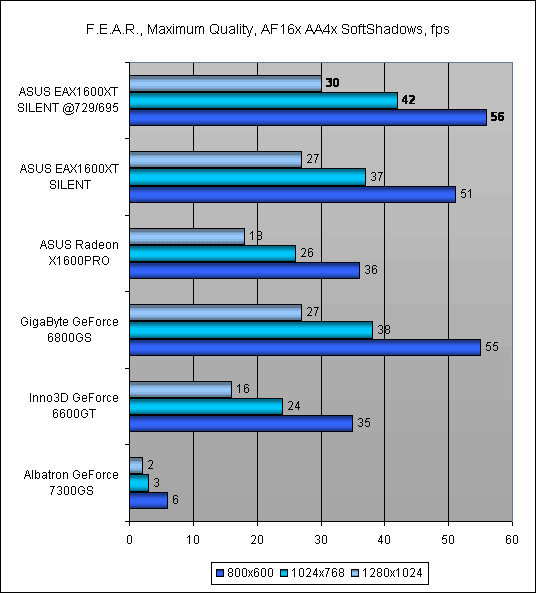 Radeon X1600XT was able to cope with the most demanding graphics engine of F.E.A.R., the results proved really impressive indeed, and overclocking moved it to the first place. Final wordsAs regards the results for ATi Radeon X1600XT, we have made conclusions regarding is capabilities repeatedly, but let me briefly remind - it offers a good price/performance ratio. But in the case with ASUS EAX1600XT SILENT no all is so straightforward. The superb noiseless cooling system on heat pipes installed on it provides comfortable operation and this comfort costs a lot. With this money, you can buy a bit more powerful solution in the form of GeForce 6800GS, and soon GeForce 7600GT will turn cheaper as well. But will these powerful alternatives be able providing a zero noise level? Here it is up to the buyer to decide what is more suitable - the speed or quietness. If quietness appears to be more important, then ASUS EAX1600XT SILENT will be an excellent choice. We appreciate "Servis" company (city of Dnepropetrovsk, Ukraine) for the video cards presented for tests. |
|
|||||